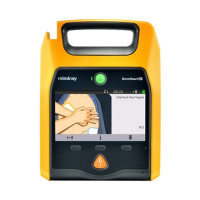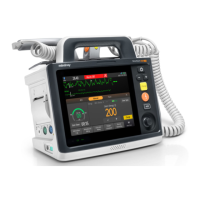13-2
13.2 Alarm Messages
This chapter lists only the most important physiological and technical alarm messages. Some messages appearing on
your equipment may not be included.
In the “Cause and solution” column, corresponding solutions are given instructing you to troubleshoot problems. If the
problem persists, contact your service personnel.
13.2.1 Physiological Alarm Messages (For Pro Only)
Physiological alarm messages are for Pro only. Alarms marked with “*” are exclusive. They have identical alarm tones
and alarm lights with normal high level physiological alarms, but their alarm messages are displayed exclusively. That
is to say, when an exclusive physiological alarm and normal high level physiological alarms are triggered
simultaneously, only alarm message of the exclusive physiological alarm is displayed.
Measurement Alarm Message Alarm Level Cause and solution
ECG Asystole* High Arrhythmia has occurred to the patient. Check the patient’s
condition, and the pads, electrode, cables and leadwires.
Shockable Rhythm* High
Vtac* High
Vent. Brady* High
Extreme Tachy* High
Extreme Brady* High
PVCs/min Medium
Nonsus. Vtac Medium
Vent. Rhythm Medium
Tachy Medium
Brady Medium
VT>2 Medium
Couplet Medium
Multif. PVC Medium
R on T Medium
Bigeminy Medium
Trigeminy Medium
PVC Low
Irr. Rhythm Low
PNP Medium The pacer appears abnormal. Check the pacer.
PNC* Medium

